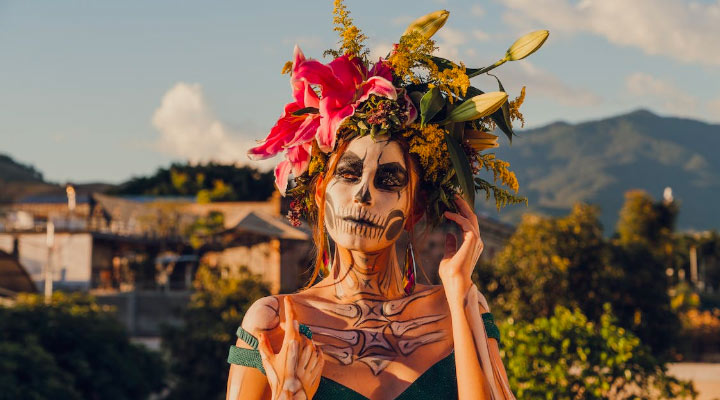Soon we all will reach death but it won’t happen on Halloween for sure. But, it is important for everyone to know what Day of the Dead in Spanish is. How does it relate to Halloween? Is it trick-or-treating and dressing up in scary masks? Or is it simply going to some old graves?
The Day of the Dead is a holiday that begins on October 31 at midnight and lasts until November 2. While many people associate this holiday with Mexico, it is also observed in other Latin American countries including Brazil, Bolivia, and Ecuador, as well as the Philippines and Spain.
What is the Day of the Dead?
The Day of the Dead is a time to remember the dead while also celebrating life. People build altars and offer offerings to the dead, and they remember them by telling stories about them. They also clean their loved one’s graves and place flowers on them to attract the spirits.
While November 1 is traditionally reserved for remembering children and is known as the Da de los Angelitos (Day of the Little Angels), November 2 is dedicated to remembering adults who have died and is known as the Da de los Muertos or the Difuntos.
Some people believe that on this day (or days), the dead resurrect. Some even believe that if the dead do not see that they are remembered on this day, they will become enraged and may haunt the living.
This ceremony is thought to have originated in pre-Columbian cultures as a way for people to honor their ancestors. It was moved from August to October/November to coincide with the Christian festival of All Saint’s Eve or Halloween in the late autumn.

So, how can you enjoy this festival if you live in a country where it is celebrated? And how can you experience the tradition if you live far away from where it is celebrated?
How to enjoy the dead of the dead?
The best way to enjoy the Day of the Dead is to stay away from the more morbid aspects of the day. There is a lot of creepy stuff going on. There’s some melancholy, heartbreak, and a yearning for loved ones to return.
Although this is a day to remember your loved ones, it is also a day to enjoy the festivities and rejoice in the fact that you are still alive. Don’t be too concerned about all the supposed spirits of the dead floating around. You are alive, you are breathing, you have a pulse, and you can party as only the living can.
If you have a loved one you want to remember and you like the idea of their spirit returning, the Day of the Dead is a good time to reflect on their lives and the good things they did, rather than being sad that they’re no longer with you.
Like all good holidays, there’s some good Day of the Dead food for those still alive, so make sure you try all the local delicacies. You should also try to participate in local customs as much as possible without being disrespectful, and take as many photographs as possible (but only where appropriate). The Day of the Dead is a vibrant celebration, particularly in Latin American countries.
Want to learn a language at italki?
Here are the best resources for you!
Important Spanish vocabulary related to the Day of the Dead
The name of the day varies by country. The day is known as the Da de las atitas (Day of the Skulls) in Bolivia. Finados (the Day of the Dead) is celebrated in Brazil.
The day is also known as the Da de Todos los Santos (Day of All Saints) or simply Todos Santos (All Saints) around the world. The 1st of November is also known as La Noche de Duelo (the Night of Pain/Sorrow).
Other words related to death (la muerte) that you will need when discussing or preparing for the Day of the Dead include la tumba (the tomb) and el atad (the coffin).
El cadáver (the corpse) plays an important role in the events of the day, and the cadáveres are buried in el cementerio (the cemetery). You could also discuss el altar (the altar), la cruz (the cross, which is frequently placed on the altar), and, of course, los espritus (spirits), los ángeles (angels), and los angelitos (little angels).
Most families will create an altar for their deceased loved ones, which will include photos of the loved one as well as food and drink that they used to enjoy. There may be music, and family members may share stories and anecdotes about the deceased.
The altar could be in the cemetery or in the family home. If you don’t live in a country where this holiday is observed, creating your own altar is probably the best way to experience the spirit of the Day of the Dead.
El alfeique is a type of candy that is used to make skulls or calaveras (as opposed to cadáveres, which are corpses), frutos (fruits), and other small figures or figurines. These items are placed on the altar and are known as ofrendas, or offerings.
It is believed that the deceased consume the essence of these offerings, after which the living are allowed to eat and drink. This appears to be working out well for everyone involved.
Other food items include pan de muerto (literally, the bread of the dead), which is a special bread made on this day. There’s also mole, a thick sauce made of chocolate, fruits, and spices (as opposed to guacamole, which is made from avocados). There’s also atole, a drink made of corn meal and water that’s flavored with fruit (in case you haven’t guessed, the dead like fruit).
Los golletes, which are pink sugared donuts, are another food item that the dead appear to enjoy.
El cempasúchil (sometimes called cempasuchil) is a yellow or orange marigold that is traditionally used in altars or placed on graves. These flowers are everywhere in the days leading up to the Day of the Dead and are said to be the flower of death (la flor de muertos). They make a cheerful symbol of death, so if death looks like a cempaschil, it can’t be all that bad. Another type of skeletal figure that represents death is the calacas.
Much of the altar decoration is made of papel picado, a type of pancake or tissue paper cut into intricate and quite beautiful designs (which also tend to stick to the skull theme). There’s also el copal (incense), which is essential in any ceremony, as well as las velas (candles) and el candelero (the candlestick), which is used to hold them. If a child has died, juguetes (toys) are sometimes placed on the altar.
You need to know how to speak Spanish if you want to attend the Day of the Dead ceremony. In the last section of this guide, we are going to look at the ways the Day of the Dead ceremony is celebrated.

The Day of the Dead ceremony
The Day of the Dead ceremony entails placing all of the above ofrendas (offerings, in case you forgot) at the altar, exchanging stories about the deceased, and eating all of the Day of the Dead goodies.
It may also include la danza de los viejitos (the dance of the old people), a lighthearted dance in which the dancers wear masks that resemble old people. El tambor (the drum) or guitar music is sometimes used to accompany this dance.
There’s also la iluminación (the illumination), a ceremony in which thousands of candles are lit. These are supposed to direct the dead souls to their respective altars. Some families scatter flower petals to lead a path from the cemetery to the altar in case the deceased become disoriented and end up at the wrong one.
Las calaveras are songs and poems written about the festival, which is a bit confusing because, as you know, la calavera means skull. Because the songs and poems are mostly about skulls, it may make sense.
Las caretas are masks worn at the end of the celebration to supposedly scare away the spirits. Máscara is another word for a mask that is more commonly used in everyday speech.
Find the best Spanish teacher at italki
The italki Spanish teacher is your one-spot solution to becoming a fluent Spanish speaker. Visit italki and learn Spanish online in the comfort of your home without compromising the quality of one-on-one sessions.

Find Your Perfect Teacher
At italki, you can find your Spanish tutor from all qualified and experienced teachers. Now experience the excellent language learning journey!
Book a trial lesson
Here, the teachers use engaging learning practices and tools to improve Spanish vocabulary, pronunciation, sentence formation as well as knowledge of Spanish culture and people. It is a great opportunity to get yourself immersed in Spanish culture before visiting Spain or any other Spanish-speaking country.
Frequently asked questions
Q. When is the Day of the Dead observed?
A. The Day of the Dead is a holiday that begins on October 31 at midnight and lasts until November 2.
Q. What are Las Calaveras?
A. Las calaveras are songs and poems written about the festival of the Day of the Dead. These songs and poems are mostly related to the skull.
Q. What is la danza de los viejitos?
A. It is the dance in which the dancers wear masks that resemble old people.
Conclusion
In this post, we have explored all the details associated with the Day of the Dead in Spanish. You can also learn body parts in Spanish to make this festival even more interesting. We recommend you be greedy for the urge to sound like native Spanish speakers. Never miss a single chance to learn and grow.
In case, you don’t understand the meaning of any Spanish term mentioned above, you can use Spanish dictionary apps to find the meaning. These apps are a great support for every language learner presently.

Learn Spanish on italki
Join the global community of language learners today! Sign up for italki and start improving your language skills with native-speaking teachers from around the world.
Create an italki account




















